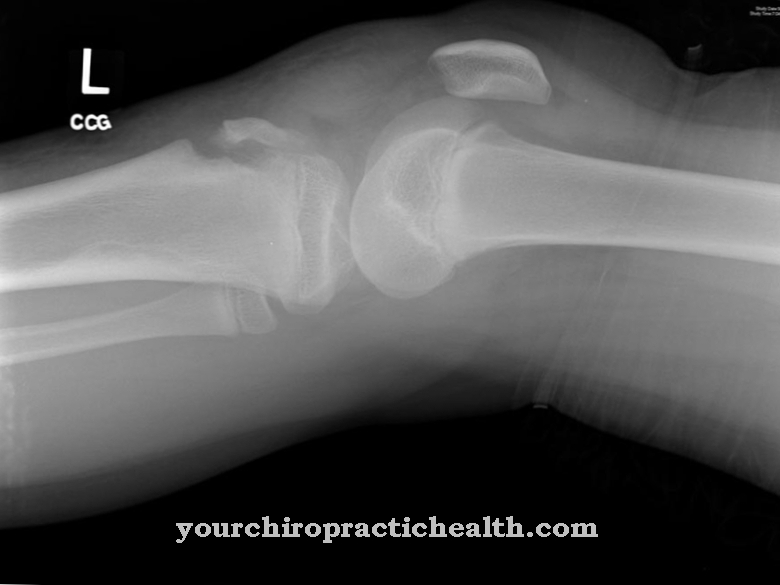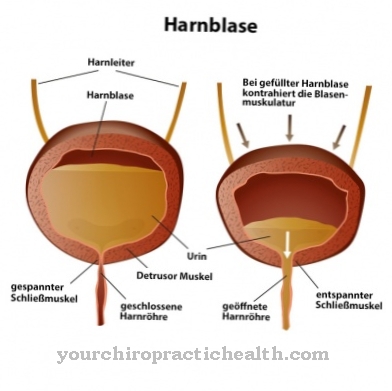In which Boerhaave syndrome it is a rupture (tear) in the wall of the esophagus. It usually occurs as a result of an increase in pressure triggered by severe vomiting. The mortality rate is over 90 percent if the perforation is not treated promptly.
What is Boerhaave Syndrome?

© lom123 - stock.adobe.com
The Boerhaave syndrome is to be differentiated from the Mallory-Weiss syndrome. This results in perforation of the mucous membrane between the esophagus and stomach as well as traumatic esophageal perforations (esophageal ruptures). Boerhaave's disease, on the other hand, is restricted to the esophagus itself and penetrates all layers of the esophagus. The rupture occurs spontaneously and requires immediate surgical treatment.
The disease is very rare and epidemiological data are scarce. Around 10 to 15 percent of all esophageal perforations can be traced back to the syndrome, with only around 900 cases known in the literature up to 1990. Men are more frequently affected than women, which was attributed to a higher proportion of alcohol-dependent men. In over 80 percent of the known cases, men were affected by Boerhaave syndrome. The disease also occurs rarely in children, with people between the ages of 20 and 40 being affected on average.
causes
The cause of Boerhaave's syndrome is a sudden, sharp increase in pressure in the windpipe. At the same time, a negative pressure is created in the chest, which is known as intrathoracic pressure. It is believed that the magnitude of the pressure increase is less important than the rate at which the pressure increases. This is due to examinations on corpses. These revealed a perforation of the lower esophagus in the distal third with a sudden increase in pressure between 150 and 200 mmHG.
Over 90 percent of the ruptures are in the lower third on the left rear. The reason for this is the anatomically determined low muscular resistance. Usually, the trigger for the perforation is massive vomiting, which earned it the name emetogenic esophageal perforation. In most cases, this vomiting is triggered by excessive alcohol consumption, which the body and especially the stomach can no longer cope with.
Other causes can be excessive physical tension or excessive pressing, as the literature suggests. But a large number of diseases can also trigger a spontaneous rupture of the esophagus. These include gastroesophageal reflux disease or esophagitis. The former is a condition in which gastric secretions flow back into the esophagus.
You can find your medication here
➔ Medicines against vomiting and nauseaSymptoms, ailments & signs
The Boerhaave syndrome has very typical symptoms (Mackler triad). Severe vomiting results in severe pain. These are referred to as so-called annihilation pain. In addition, either skin emphysema or mediastinal emphysema can occur. This refers to an ascending or spreading accumulation of gas under the subcutaneous tissue or in the area of the middle layer.
There are also other signs that could indicate Boerhaave's syndrome. On the one hand, signs of shock such as a drop in blood pressure and cold sweats can occur. On the other hand, many people affected suffer from shortness of breath (dyspnea) and a lack of oxygen (cyanosis). Vomiting of blood, known as hematemesis, is also possible.
Diagnosis & course
If a rupture of the esophagus is suspected, call an ambulance immediately. The diagnosis is made after first aid measures via x-rays. The images show air sickles under the domes of the diaphragm. In addition, the air leakage into the mediastinum can be visible. Other tests that a health professional may initiate include esophagography and esophagoscopy.
The former is a contrast agent examination. The contrast agent enters the mediastinum if it is perforated. This examination is considered to be less risky. An esophagoscopy, on the other hand, is an endoscopic reflection of the esophagus. Depending on the case, the tear can also be sewn. However, this method can lead to complications and further tearing of the rupture.
Boerhaave's syndrome must be differentiated from acute pancreatitis, ulcer perforation and heart attack, among other things. In addition, the symptoms are similar to a pneumothorax, in which air in the pleural space prevents the lungs from expanding. In addition, a differential diagnosis should be made to rule out aortic dissection. The inner vessel walls tear, which in turn leads to bleeding and splitting of the wall layers of the main artery.
To rule out a heart attack, it is also useful to initiate an EKG. Computed tomography is also performed. A diagnosis is not possible with a purely external examination of the patient.
Complications
In Boerhaave's syndrome, death occurs in a very large number of cases if treatment is not carried out immediately. As a rule, Boerhaave syndrome occurs after or during vomiting, after which the patient experiences extremely severe pain. In many cases, this pain leads to unconsciousness.
The patient suffers from a sharp drop in blood pressure, with damage to the heart and other organs. There are also panic attacks and the development of so-called cold sweats. Most patients show gasping for breath. If the vomiting continues, blood may also be vomited.
If the emergency doctor cannot treat the patient immediately, death will result. Treatment for Boerhaave syndrome takes place surgically. It will be successful if it is initiated immediately after entry and without delay.
In most cases, the person concerned still has to take antibiotics after treatment to ward off inflammation and infections. This can lead to complications if the hygiene is poor or if the medication is not taken. People who are addicted to alcohol are more likely to have Boerhaave syndrome.
When should you go to the doctor?
Prompt treatment is necessary for Boerhaave syndrome. If this complaint is not dealt with immediately, the patient will usually die. If you have Boerhaave syndrome, you should call an emergency doctor or go to the hospital immediately. Unfortunately, there are no opportunities for self-help available to those affected. The emergency doctor must be consulted if extremely severe pain occurs after vomiting. These pains are described by patients as annihilation pains.
Gas can also build up under the skin, which is also a sign of Boerhaave's syndrome. An emergency doctor must also be called if the patient has difficulty breathing or cold sweats. Blue skin and lips can also indicate the syndrome and must be treated immediately. In many cases, however, patients also lose consciousness. Usually the emergency doctor has to be called in Boerhaave syndrome. The earlier this arrives, the higher the patient's chances of survival.
Doctors & therapists in your area
Treatment & Therapy
Therapy takes place via a thoracotomy or laparoscopy, in which the rupture is sutured. In a thoracotomy, the thorax is surgically opened by making an incision in the area between the ribs. This should be done within 24 hours of the rupture. During a laparoscopy (laparoscopy), interventions are made inside the abdominal cavity. Under certain circumstances, the Boerhaave syndrome is covered plastically with surrounding tissue.
In this way, the seam is stabilized with the body's own tissue. After the operation, concomitant antibiotic therapy is required as there is a risk of infection. In addition, the patient has to be under intensive medical observation for some time. The mortality (lethality) in the syndrome is between 20 and 40 percent.
Outlook & forecast
Boerhaave's syndrome is an extremely serious disease that is fatal if left untreated. If treatment starts immediately, the mortality rate drops. It is still at 20 to 40 percent.
The healing process is also influenced by the possible complications. Even the usual symptoms of the disease such as shortness of breath, circulatory shock or vomiting of blood can quickly lead to death.Death can occur through bleeding to death, through cardiac arrest or through insufficient oxygen supply to the organism and especially to the brain. The risk becomes even greater if complications such as mediastinitis or sepsis also occur. The fastest possible operation contributes to hemostasis and stabilization of the circulation.
The patient's further recovery now depends on how severely he is already affected by the lack of oxygen in the body. Furthermore, immediate treatment with antibiotics is necessary in order to avert a bacterial infection with all its complications (sepsis, mediastinitis). Both sepsis and mediastinitis can lead to death from multiple organ failure.
The only way to avoid a fatal course of the disease is to surgical opening of the thorax (thoracotomy) or opening of the abdominal cavity (laparotomy) to close the tear in the esophagus when antibiotic treatment with broad spectrum antibiotics is used.
You can find your medication here
➔ Medicines against vomiting and nauseaprevention
As mentioned earlier, Boerhaave syndrome is extremely rare. However, there are no known preventive measures. However, there are risk groups in which the syndrome occurs more frequently. This particularly includes people who have serious alcohol problems.
Aftercare
Follow-up care for Boerhaave syndrome will depend on the course of the syndrome and any complications that may have occurred during treatment. If the tear in the esophagus is identified and treated early, the prognosis is generally good. Follow-up care focuses on regular check-ups by the doctor. Among other things, the doctor will perform ultrasound examinations and check wound healing in the esophagus.
Any accompanying symptoms are discussed during a patient consultation and the doctor can prescribe suitable medication. In addition, the rare syndrome is to protect the esophagus. This is achieved through an adapted diet, which, however, has to be regularly adjusted to the progressively improving state of health.
If the injury has been treated surgically, the patient must first stay in the hospital for a few days. If there are no further complications, the clinic can be left after a week. Before that, the doctor will carry out a final examination and give the patient general tips on hygiene, diet and stress on the esophagus.
One week after the patient has left the hospital, another check-up should be carried out by the ENT doctor, whereby the wound healing is primarily checked and the medication adjusted if necessary.
You can do that yourself
Boerhaave syndrome is treated with drugs and surgery. As a means of self-help, supportive dietary measures and rest are recommended. The patient should not expose himself to any physical strain, especially in the days after the operation. Any surgical wounds must be cared for according to the doctor's instructions. If a wound opens or becomes infected, it is advisable to see a doctor.
If pancreatitis is part of the disease, a healthy and balanced diet and regular fluid intake must be ensured. The medically prescribed painkillers can be supplemented with natural medicine in consultation with the doctor. For acute symptoms such as nausea and vomiting, warm compresses or pads with ointments are recommended. The pancreatitis should heal within one to two weeks if the patient takes care of himself and supports the recovery through the measures mentioned.
If there are signs of a heart attack, emergency services must be called. The sick person should get into a quiet position until medical help arrives. Any first aiders must reassure the person affected and, in the event of cardiac arrest, initiate resuscitation measures such as chest compressions. Ulcer perforation or aortic dissection are also medical emergencies in which the emergency services must be called.



























